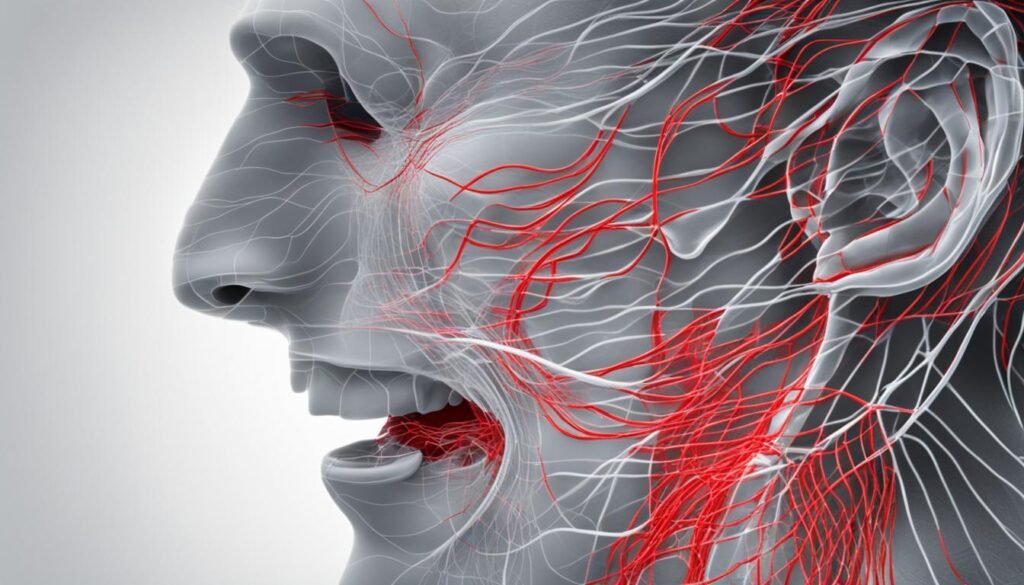What does somatic tinnitus sound like? This is a key question for understanding this unique form of tinnitus influenced by body movements or positions. Somatic tinnitus is characterized by changes in the perception of sound, which can vary in intensity or pitch based on specific physical activities or changes in body posture. The underlying mechanisms of somatic tinnitus are complex and not entirely understood, but it’s believed to arise from the interactions between auditory and somatosensory pathways in the brain.

Identifying the sounds associated with somatic tinnitus can be challenging, as they often vary from person to person. Common descriptions include buzzing, ringing, or humming sounds that fluctuate with certain bodily movements. Understanding these auditory experiences is crucial for individuals with this condition, as it can guide effective management and treatment strategies.
Key Takeaways:
- Somatic tinnitus is characterized by changes in sound perception related to body movements or positions.
- The exact causes and mechanisms of somatic tinnitus are still being studied.
- The interaction between auditory and somatosensory pathways in the brain plays a role in somatic tinnitus.
- Collaboration between specialists from various fields is essential for diagnosis and management.
- Gentle jaw massages and relaxation exercises can help alleviate the discomfort associated with somatic tinnitus.
What is Somatic Tinnitus?
Somatic tinnitus, also known as somatosensory tinnitus, is a unique form of tinnitus characterized by the perception of sound being triggered or modulated by movements or positions of the body. When individuals engage in specific activities or alter their body’s posture, they may experience changes in the intensity or pitch of their tinnitus.
Unlike other forms of tinnitus that are solely related to issues within the auditory system, somatic tinnitus involves the interaction between auditory and somatosensory pathways in the brain. This complex interaction can result in the perception of sound when certain body movements occur.
Understanding the definition and triggers of somatic tinnitus is crucial in developing effective management strategies for individuals experiencing this form of tinnitus. Individuals can find relief and improve their quality of life by identifying and addressing the underlying factors contributing to somatic tinnitus.
The Causes of Somatic Tinnitus
Somatic tinnitus is a complex condition with various underlying causes that contribute to its manifestation. While the exact mechanisms are still not fully understood, researchers have put forward several theories to explain the origins of somatic tinnitus. One prevailing theory suggests that somatic tinnitus results from dysfunctions in the sensory pathways responsible for proprioception and the auditory pathways in the brain.
Proprioception, which refers to our awareness of body position, can become disrupted in individuals with somatic tinnitus. This disruption may occur due to the presence of somatosensory nerves connected to the dorsal cochlear nucleus. These nerves send mixed signals to the brain, leading to the perception of sound when certain body movements or positions are adopted.
Another theory proposes that somatic tinnitus may stem from abnormalities in the somatosensory cortex, a brain region that processes sensory information. It is believed that altered crossmodal interactions between the auditory and somatosensory pathways could result in misinterpreting sensory signals, leading to the perception of tinnitus.
Theories on the sensory pathways and somatic tinnitus:
- Disruptions in proprioceptive pathways
- Presence of somatosensory nerves connected to the dorsal cochlear nucleus
- Abnormalities in the somatosensory cortex
- Altered crossmodal interactions between auditory and somatosensory pathways
While these theories provide valuable insights into the potential causes of somatic tinnitus, further research is needed to understand the complex mechanisms of playfully. By unraveling the underlying causes, researchers hope to develop more targeted and effective treatments for individuals suffering from somatic tinnitus.
Conditions That Contribute to Somatic Tinnitus
Several factors and conditions can contribute to the development or exacerbation of somatic tinnitus. It is important to understand these underlying conditions to manage and treat somatic tinnitus effectively. Here are some of the key conditions associated with somatic tinnitus:
- Temporomandibular Joint (TMJ) Disorders: TMJ disorders affecting the jaw joint can cause somatic tinnitus. Issues such as misalignment, inflammation, or muscle tension in the jaw joint can disrupt the auditory and somatosensory pathways, leading to the perception of sound.
- Dental Issues: Dental problems, such as teeth grinding (bruxism) or malocclusions (misalignment of the teeth or jaws), can contribute to somatic tinnitus. These issues can create tension and imbalance in the muscles and joints of the jaw, affecting the sensory signals involved in tinnitus perception.
- Neck and Spinal Problems: Conditions affecting the neck and spine, such as cervical spondylosis or herniated discs, can influence somatic tinnitus. Nerve impingement or muscle tension in these areas can disrupt normal sensory processing and contribute to the perception of tinnitus.
- Persistent Muscle Tension: Chronic muscle tension in the jaw, neck, and shoulders can play a role in somatic tinnitus. Tense muscles can affect the blood flow, nerves, and sensory pathways, manifesting or intensifying tinnitus symptoms.
Identifying and addressing these underlying conditions is crucial in managing somatic tinnitus. A comprehensive evaluation by specialists, such as dentists, orthopedics, or physiotherapists, can help determine the specific factors contributing to an individual’s somatic tinnitus. By targeting and treating these conditions, it may be possible to reduce the severity or frequency of somatic tinnitus symptoms.

Coping Strategies for Somatic Tinnitus
Living with somatic tinnitus can be a challenging experience, but there are coping strategies that individuals can employ to manage its effects. One technique to alleviate symptoms is gentle jaw massages. Massaging the jaw can help relieve tension and reduce potential triggers for somatic tinnitus. This technique reduces discomfort associated with jaw tension and promotes relaxation and overall well-being.
Another effective coping strategy is jaw relaxation exercises. These exercises aim to relax the muscles surrounding the jaw and improve flexibility. One exercise involves gently opening and closing the mouth while focusing on keeping the jaw muscles relaxed. Deep breathing exercises can also be incorporated into jaw relaxation exercises to enhance relaxation and reduce stress levels.
Can wisdom teeth cause tinnitus? Uncover the surprising link between oral health and hearing, where we discuss how these seemingly unrelated aspects are connected.
Stress reduction techniques can be beneficial in further aiding in managing somatic tinnitus. These techniques can include activities such as yoga, meditation, and mindfulness practices. Regularly engaging in these activities can help individuals better cope with the emotional and psychological impact of somatic tinnitus.
In addition to these coping strategies, individuals with somatic tinnitus must seek support from healthcare professionals. Audiologists, dentists, and other specialists can provide guidance, support, and customized treatment plans based on individual needs. By implementing coping strategies and seeking professional help, individuals with somatic tinnitus can improve their quality of life and relieve their symptoms.
The Role of Diagnosis in Somatic Tinnitus Management
Correctly diagnosing somatic tinnitus is crucial for effective management of the condition. A comprehensive audiological evaluation, including a diagnostic hearing assessment, can provide valuable insights into any underlying hearing-related issues that may contribute to somatic tinnitus perception. By understanding the specific auditory and somatosensory pathways involved, healthcare professionals can develop personalized treatment strategies to help alleviate symptoms and improve overall quality of life.
Collaboration with specialists from various fields, such as dentists, gnathologists, osteopaths, orthopedics, and physiotherapists, may be necessary to identify potential somatic disorders that could be contributing to tinnitus. In some cases, somatic disorders like temporomandibular joint (TMJ) disorders or neck and spinal problems can influence the perception of tinnitus. By working together, healthcare professionals can paint a more complete picture of the individual’s condition and tailor treatment options accordingly.
The diagnostic process may involve a range of assessments, including physical examinations, imaging studies, and questionnaires, to gather relevant information about the individual’s medical history and symptoms. This comprehensive approach helps ensure that all potential factors contributing to somatic tinnitus are thoroughly evaluated and addressed.
Benefits of a Multidisciplinary Approach
A multidisciplinary approach to somatic tinnitus diagnosis and management offers several benefits. Firstly, it allows for a holistic evaluation of the individual’s condition, considering both the auditory and somatosensory aspects. This comprehensive assessment can lead to a more accurate diagnosis and a better understanding of the underlying mechanisms at play.
Secondly, a multidisciplinary team can provide various expertise and perspectives. Each specialist can contribute their unique knowledge and skills to develop an individualized treatment plan addressing the patient’s needs. This collaborative approach ensures that all aspects of the individual’s health are considered and that the treatment plan is tailored to their specific somatic tinnitus presentation.
In conclusion, the role of diagnosis in somatic tinnitus management cannot be understated. Healthcare professionals can identify and address the underlying factors contributing to somatic tinnitus through a comprehensive audiological evaluation and collaboration with specialists from various fields. This multidisciplinary approach leads to personalized treatment strategies that aim to alleviate symptoms and improve the overall well-being of individuals living with somatic tinnitus.
Somatic Tinnitus: Case Studies and the Complexity of Diagnosis and Treatment
Somatic tinnitus is a complex condition requiring individualized diagnosis and treatment approaches. The experiences of patients with somatic tinnitus highlight the multifaceted nature of this condition and the need for comprehensive evaluations and tailored therapeutic strategies. Case studies provide valuable insights into individuals’ challenges with somatic tinnitus and the potential paths toward symptom relief and improved quality of life.
“Living with somatic tinnitus can be overwhelming, as the perception of sound is influenced by my body movements. Through collaboration with various specialists, I have gained a better understanding of the underlying somatic disorders contributing to my tinnitus. It has been crucial in formulating a personalized treatment plan that addresses both my auditory and somatosensory pathways.”
Diagnostic and therapeutic approaches for somatic tinnitus involve collaboration between professionals from different fields, including audiology, dentistry, gnathology, osteopathy, orthopedics, and physiotherapy. By combining their expertise, these specialists can conduct comprehensive evaluations to identify and address somatic disorders that contribute to tinnitus perception. These evaluations may include audiological assessments, diagnostic hearing evaluations, and investigations into potential somatic issues such as temporomandibular joint disorders or neck and spinal problems.
Somatic Tinnitus: A Multidisciplinary Effort
Successful management of somatic tinnitus relies on a multidisciplinary approach that considers the unique needs of each individual. By integrating the findings from case studies and collaborating with professionals from various fields, healthcare providers can develop personalized treatment plans tailored to address the underlying somatic disorders and relieve somatic tinnitus symptoms.
Continued Research and Hope for the Future
As research into somatic tinnitus progresses, a deeper understanding of the underlying mechanisms and developing more effective therapeutic approaches hold promise for individuals with this condition. The complexities of somatic tinnitus necessitate ongoing research, innovative treatment methods, and further collaboration between medical professionals to improve the quality of life for those affected.
Conclusion
Somatic tinnitus is a unique form of tinnitus characterized by the modulation of sound perception through movements or positions of the body. While the exact mechanisms and underlying causes are still being studied, a better understanding of the brain’s interaction between auditory and somatosensory pathways sheds light on this complex condition.
Diagnosis and management of somatic tinnitus require a multidisciplinary approach, with collaborations between audiologists, dentists, gnathologists, osteopaths, orthopedics, and physiotherapists. Individuals with somatic tinnitus can experience improved quality of life and relief from their symptoms by identifying and addressing underlying somatic disorders.
Can hypertension cause hearing loss? Find out more
Further research is needed to comprehend the complex mechanisms of somatic tinnitus fully. As scientists continue to investigate this condition, it is hoped that more effective diagnostic and therapeutic approaches will emerge, providing individuals with better tools for managing their symptoms and improving their overall well-being.
Frequently Asked Questions
What is somatic tinnitus?
Somatic tinnitus is a unique form of tinnitus triggered by movements or positions of the body. It is characterized by changes in the intensity or pitch of tinnitus when engaging in specific activities or altering body posture.
What are the causes of somatic tinnitus?
The exact underlying causes of somatic tinnitus are not fully understood, but it is believed to result from the brain’s interaction between auditory and somatosensory pathways. Factors such as temporomandibular joint (TMJ) disorders, dental issues, neck and spinal problems, and muscle tension can contribute to somatic tinnitus.
How can I cope with somatic tinnitus?
Coping strategies for somatic tinnitus include gentle jaw massages and regular jaw relaxation exercises to relieve tension and reduce triggers for somatic tinnitus. These techniques promote relaxation and overall well-being.
How is somatic tinnitus diagnosed?
A comprehensive audiological evaluation, including a diagnostic hearing assessment, can help identify any underlying hearing-related issues that may contribute to somatic tinnitus perception. Collaboration with specialists from various fields, such as dentists, gnathologists, osteopaths, orthopedics, and physiotherapists, may be necessary to identify potential somatic disorders.
Are there any case studies on somatic tinnitus?
Yes, case studies of patients with somatic tinnitus highlight the complexity of the condition and the importance of individualized approaches to diagnosis and treatment. Collaborating with specialists from different fields ensures a comprehensive evaluation and tailored therapeutic strategies.



